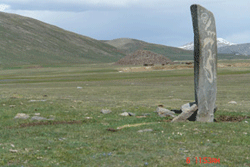The Sanhaizi society inherited some of its cultural traits from the Andronovo period. It grew through interactions with various cultures distributed throughout the eastern Eurasian steppes and with the civilizations of Shang and Zhou dynasties. Its favorable geopolitical condition further facilitated the development of the Sanhaizi culture development into a hegemonic power in the eastern Eurasian steppes. This may have triggered the first wave of large-scale east-to-west migrations in about the 8th century BC.
Simultaneous with the rise of the Sanhaizi culture, the cultures the Great Wall region played an important mediating role between the steppe region and the Central Plains of China between the late Shang and the Eastern Zhou periods.
Guo Wu received both his bachelors and masters degree in archaeology and history from Peking University. In 1999 he joined the Institute of Archaeology of the Chinese Academy of Social Sciences and become a members of its Research Center for Borderland Archaeological Studies in Xinjiang. He has since completed his Ph.D. in history at the Chinese Academy of Social Sciences and continues to study the archaeology of Xinjiang and cultural exchange between Chinese and Western societies.
Image

